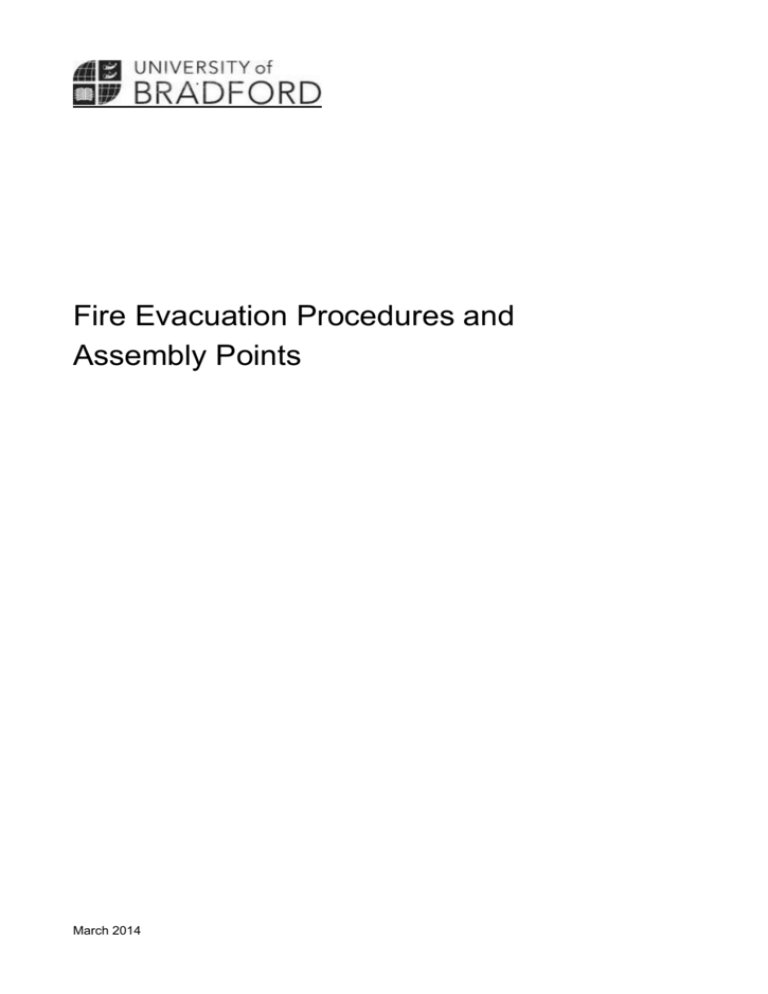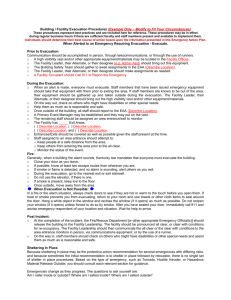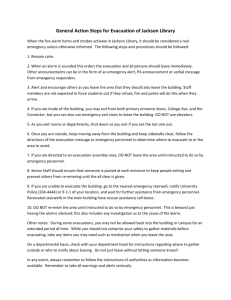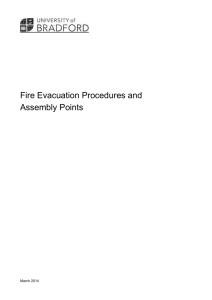Fire Evacuation Procedures
advertisement

Fire Evacuation Procedures and Assembly Points March 2014 Contents Introduction ....................................................................................................................................................... 3 University of Bradford ....................................................................................................................................... 4 Fire Safety Policy Statement .............................................................................................................................. 4 Action to be taken ............................................................................................................................................. 5 if you discover a fire .......................................................................................................................................... 5 Disabled persons ............................................................................................................................................... 6 Individuals with responsibilities ........................................................................................................................ 7 2 Introduction The purpose of this document is to introduce the evacuation strategy which is adopted throughout all University academic and student residence buildings and give guidance in certain areas to facilitate a smooth evacuation process. This document aims to remove any confusion on the hearing of fire alarm systems. The enclosed plans will assist in the identification of an appropriate assembly point with varying locations for different University buildings. In addition, routes are indicated dependent upon which exit from a building is used. All personnel should familiarise themselves with the most appropriate assembly point for the building in which they normally work, and where applicable any additional assembly points for their building should the normal exit route be obstructed. Any queries should be directed to the University Fire Safety Officer who is contactable on extension 5764. 3 University of Bradford Fire Safety Policy Statement The University of Bradford recognises that fire can have a devastating effect on life as well as its business and activities and is totally committed to providing a safe environment for study and work. The University of Bradford will ensure so far as is reasonably practicable that all staff, students, contractors and visitors are protected from the risks and effects of fire, and will take such general fire precautions as may reasonably be required to ensure their safety. Emergencies require people to react in certain ways to ensure their safety; this includes safe evacuation procedures from buildings. In order to give people the knowledge they need to undertake this, fire drills are conducted at least once every academic year. The fire drills will also help to highlight any deficiencies or defects in our procedures. It is the responsibility of each individual, whether staff, student, visitor or contractor to cooperate with the emergency procedures implemented by the University. This document forms part of the schedule of the Fire Safety Policy. Within this Evacuation document, there are a number of foreseeable scenarios along with an explanation of the action to be followed in each case, please note set procedures for predictable situations cannot be laid down, as there are too many variables of a given situation, which may dictate how the incident and evacuation are best handled. As a general principle one of progressive horizontal evacuation should be used, i.e. putting as much distance between yourself and the fire whilst remaining on the same floor level, this is particularly the case for persons with a disability. Staff are once again reminded that under health and safety legislation we are all responsible for our own safety and that of others who may be affected by our actions or in-actions. At no time should people act in a reckless or negligent manner that could lead to a fire situation or obstruction of fire exits or exit routes, nor should things provided in the interests of safety be tampered with or misused. 4 Action to be taken if you discover a fire Raise the alarm – this can be done by shouting and or operating one of the red break glass call points, these are generally located on exit routes or the way out of a room next to the door. If it is safe to do so close any open windows and doors If it is safe to do so and you have been trained in the use of fire extinguishers, then tackle the fire by using an appropriate extinguisher provided, keep your back to the exit route and if the fire extinguisher is not making any difference and the fire continues to increase in size leave the room immediately. Leave by the nearest available exit, this may not be the point at which you entered the building. Do not Stop to collect personal belongings, Action to take upon hearing the fire alarm or on receipt of a verbal instruction to evacuate the building Leave the premises by the nearest available exit, this is not necessarily the way you entered the building. Once outside the building proceed to the nearest assembly point. Move away from the building, (in a fire situation glass shatters and concrete explodes). Do not re-enter the building until given the all clear by security personnel. Please note; failing to proceed to an assembly point can be both dangerous to the individual and obstructive to the Emergency Services. Additionally, it is the responsibility of each individual to follow the evacuation protocol promptly upon hearing the fire alarm, in the event of a bomb threat or similar type of emergency it may be necessary to initiate this procedure verbally. 5 Disabled persons Persons with a disability should proceed to a refuge at the furthest point within a building from the fire. The majority of refuges are located in stairwells; their location is indicated by appropriate signage. As an example of the procedure in the event of an alarm activation, if we look at the facilities and lay out of the Richmond Building, if the alarm activation was on the Richmond wing, evacuees should, providing it is safe, proceed to the central lift lobby initially, then to the end of the Carlton wing. In this location, there is a refuge with voice communication facilities, if it was not safe to proceed to the Central lift lobby or the Carlton wing because of the location of the fire, then the lift lobby at the end of the Richmond wing could be used. The communication facilities within the refuge can be used to contact Security, who will advise the person to either: a) Remain at the refuge until the alarm has been investigated, b) Commence descent if able, c) Arrange for assistance to be sent, A new system for voice communications is being installed in other buildings, this system will allow Emergency Wardens to communicate with both security and directly to the person waiting at the refuge. Personal Emergency Evacuation Plans (PEEP’s) PEEP’s are personalised evacuation plans for people with a disability whether permanent or temporary who would need assistance to evacuate a building in the event of an emergency, particularly where this is mobility related, as lifts should not be generally used in emergencies. Any person who does not have one of these but feels they would need assistance to evacuate should contact the University Fire Safety Officer, who can be reached by email S.W.Wiggins@Bradford.ac.uk ). Phased Evacuation The Richmond Building is currently the only building within the University portfolio that has phased evacuation; this is a process of evacuating only certain parts of the building to limit the disruption. The way in which this currently works is that the floor where an alarm has been received would evacuate along with the floor directly above, e.g. fire alarm activated on E floor Carlton, alarm sounds on E and F floors of Carlton only. Persons in these areas should then evacuate the building by the nearest available exit. 6 Individuals with responsibilities Academic Staff – Staff who are teaching at the time of an incident should try to ensure that their teaching area is evacuated by all students. They should make everyone under their guidance aware that the fire alarm has sounded and of the need to evacuate the building immediately. In the event of their being someone within their charge who has a disability, they should assist the student in locating their safe refuge point. Academic staff may choose to leave the building or stay with the student until the alarm has been investigated and the all clear given or until assistance arrives. All disabled persons should have been given a Personal Emergency Evacuation Plan (PEEP) and should know what action to take in the event of an emergency. Students – Students are responsible for their own safety and will be expected to follow any instruction or guidance given during any emergency. Technical/Support staff – Support staff should follow the guidance contained within this document, however it is expected that they would endeavour to ensure any person present within their work area who is unfamiliar with the procedure or suffering from a disability, is given guidance and assistance on the actions to take during the emergency incident where appropriate. Emergency Wardens – These are University staff who have volunteered to provide assistance and support during an emergency. They will guide evacuees to exit routes and conduct an internal sweep of the area where they normally work to ensure occupants have evacuated. Outside the building wardens will guide evacuees to assembly points and away from any potential danger. Emergency wardens will liaise with Security and the Emergency Services, and assist in the evacuation of persons within emergency refuges should it be necessary. All personnel are respectfully reminded that wardens are volunteers and play an important role within the evacuation procedure, they should not be give any verbal abuse for the task they have been asked to undertake, persons who are either abusive or fail to evacuate the building will be dealt with severely through the appropriate channels. Security Personnel – Security personnel will be investigating the alarm activation and should not be relied upon to assist in evacuation, they will also give the instruction that it is safe to re-enter a building following an emergency. 7 8 9 10 Remember GET OUT & STAY OUT 11








